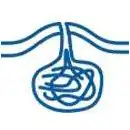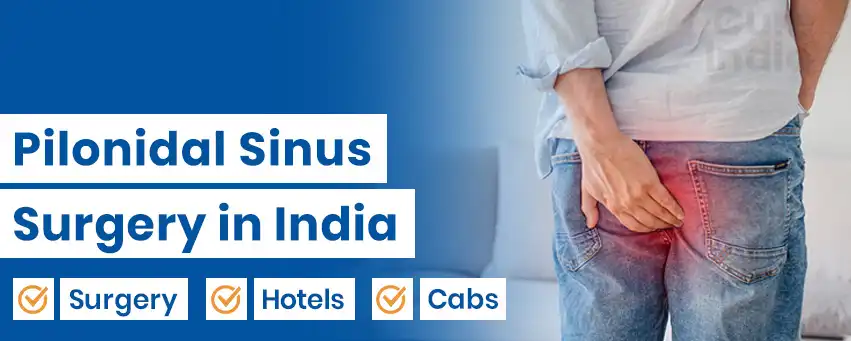

A pilonidal sinus is a small tunnel or a hole in the skin that occurs due to increased pressure and friction in the anal area, pushing the hair inwards from the buttocks area. It develops in the cleft between the buttocks near the tailbone (coccyx). It gets filled with pus, debris, and fluids and forms an abscess or a cyst. It is known as pilonidal abscess disease or pilonidal cyst. Along with the debris and pus, sometimes it also gets filled with dirt and hair. Due to this, it causes an infection resulting in severe pain. If not treated, it can spread and infect the nearby body parts, Due to an infection, the blood and pus with a foul odor ooze out from a pilonidal sinus. Men are most likely to develop a pilonidal sinus and it is also quite common in young adults. It mostly affects people who sit a lot, have a job that requires them to sit for longer periods, etc.
A lot of people from many African countries like Congo, Ghana, Rwanda, and Uganda visit India every year for the treatment of pilonidal sinus. As the cost of treatment in India is very low, it is beneficial for global patients as they get a premium medical service at a very low cost. Indian hospitals for pilonidal sinus have the latest infrastructure and modern facilities which helps in providing a very comfortable treatment to the patients. The surgeons in Indian hospitals have many years of experience and they are trained internationally to gain a wide angle of knowledge. Also, the cost of medicines is very less due to a lot of pharma companies present in India.
The exact cause of pilonidal abscess is not known. However, as most of the cases of pilonidal sinus arise after puberty, it is considered that it might be caused due to hormonal changes that the body goes through, the hair growth in the area, and may be due to the friction that is caused by the fitted clothes and sitting for extended period of time.
Activities that cause friction in the area such as sitting for longer periods, might cause the hair in the buttocks area to burrow into the skin making a puncture. When this happens, our body’s immune system considers the puncturing hair to be a foreign particle and attacks that area in response to fight against the hair just like it does with any foreign body like microorganisms. You can understand it better if you take an example of a splinter. When you have a splinter stuck in your skin, you have the same immune response. This gives rise to pilonidal abscess disease.
Some of the common causes of pilonidal abscess are mentioned below.
The pilonidal abscess symptoms vary according to the severity of the condition. However, the common symptoms include:
These are the common symptoms that you may develop quickly or it may take about few days to develop the symptoms. If the pilonidal sinus is not treated, it can cause a very rare skin cancer known as squamous cell carcinoma.
The pilonidal sinus disease can be managed with simple measures and the surgical procedure is not needed in many cases. Managing and treating a pilonidal sinus involves removing the hair in that region, draining the abscess, washing and cleaning it with a disinfecting solution, and closing it with stitches. However, if it has started to spread to the other body parts, pilonidal sinus surgery is required to completely remove the pilonidal cyst. Some of the surgical methods for pilonidal cysts are mentioned below.
It is a minor surgical procedure where the surgeon makes a small incision/cut in the abscess, drains the pus and other materials out from the cyst, disinfects the area, and then the cyst is packed with a thin, net-like material made up of cotton known as gauze.
This method is similar to the lancing procedure but the only difference is the wound is not closed after removing the pus and other debris from the cyst. The wound is left to heal on its own.
As the name suggests, in this procedure, your surgeon will make a cut on the abscess, drain the pus and debris, clean the area, and close the wound with stitches.
It is a type of procedure where the slit is cut in the abscess and the edges of the slit are stitched with the sutures from the outer surface towards the inner surface of a cyst. The wound will be left open to allow the pus and debris to drain freely.
In this procedure, your surgeon changes the shape of the cleft between the buttocks and makes it shallow (slightly flat), this helps in better healing of the pilonidal sinus. By doing so, you can avoid the collection of loose hair in the cleft and also it prevents the growth of bacteria which are most likely to cause an infection.
In this procedure, a laser is used to treat the condition. It is a minimally invasive method that is preferred by most of the patients as it heals faster and the blood is not lost during the procedure. In this procedure, a small cut/incision is made on the abscess, the pus and debris are drained off, and the surgeon seals the sinus tract with a laser fiber. When this method is used, there are no chances of reoccurrence of this condition.
It is very important to keep the area surrounding the cyst clean after the treatment procedures. You should keep the area free of hair and moisture. Maintain a good hygiene practice and dry the area whenever needed. Remove the hairs frequently, this will prevent the reoccurrence of pilonidal sinus disease. The complete recovery from the surgery will take about 1 to 3 months but with the laser treatment, you will be completely recovered within 30 to 50 days. If you had a laser treatment then you will be discharged from the hospital on the same day and if other methods are used, then you may need to stay at the hospital overnight. Some of the preventative measures that you should follow to prevent it from reoccurring are listed below.
Many people from African countries like Nigeria, Kenya, and Ethiopia travel to India seeking the best treatment with minimum cost. There are different procedures for this condition available in Indian hospitals. The surgeons in India are extremely skillful and use the latest modern technologies to treat Pilonidal Sinus. Treatments like SPD, LPP, Excision, Z-Plasty, Cleft Lift, and Limberg Flap treat Pilonidal Sinus in Indian hospitals. Also, the average cost of Pilonidal Sinus treatment in India is much more affordable for international patients than in other countries. The cost of Pilonidal Sinus in India is:
| Treatment | Cost in India | Stay in India |
|---|---|---|
| Pilonidal Sinus Treatment in India | $1,500-$2,000 | 5-7 Days |
The Pilonidal sinus may cause irritation, pain, and discomfort near the anal area between the buttocks cleft as it is filled with pus and other debris. The pilonidal sinus symptoms include pain while sitting, discomfort, pus, and blood draining from the affected are accompanied by a bad odor, nausea, etc. If not treated early, it can spread to the other body parts that are near the affected area. The treatment of the pilonidal sinus involves removing the pus, dirt, hair, and other debris from the pilonidal cyst and cleaning the wound. Some types of treatments include closing the wound whereas sometimes it is left open. The cost of the pilonidal cyst treatment varies greatly in different countries. The pilonidal sinus surgery cost in India is minimal and it is lowest as compared to many other countries. The hospitals and medical staff in the hospitals of India are highly cooperative and make a huge effort to provide premium medical services. You can choose one of the many different packages that many top hospitals in India provide. Do consider India for your pilonidal cyst removal procedure, you will have a good experience.
